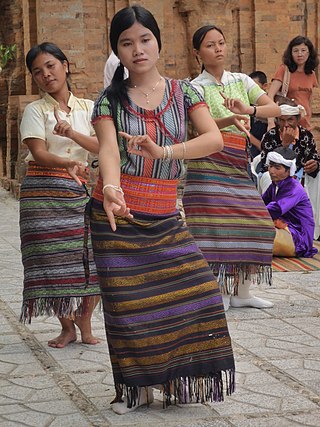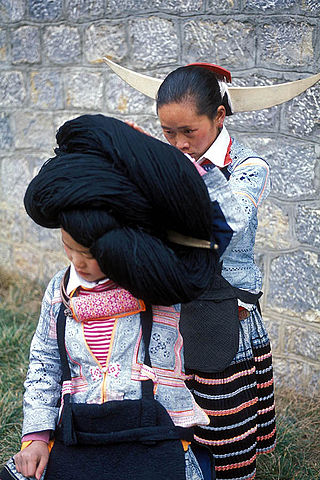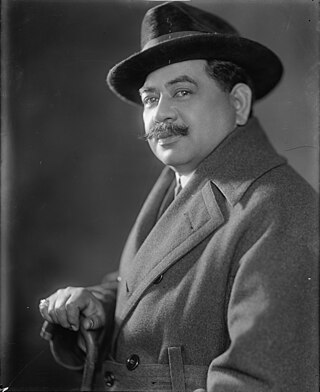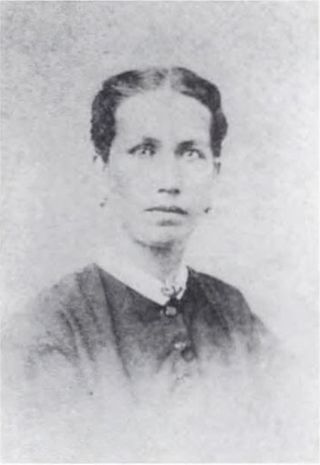Related Research Articles

The Chams, or Champa people, are an Austronesian ethnic group in Southeast Asia as well as an indigenous people of central Vietnam. They are the original inhabitants of coastal areas in Vietnam and Cambodia, along the South China Sea, since before the arrival of the Cambodians and Vietnamese, during the expansion of the Khmer Empire and the Vietnamese conquest of Champa.

The Miao are a group of linguistically related peoples living in Southern China and Southeast Asia, who are recognized by the government of China as one of the 56 official ethnic groups. The Miao live primarily in the mountains of southern China. Their homeland encompasses the provinces of Guizhou, Yunnan, Sichuan, Hubei, Hunan, Guangxi, Guangdong, and Hainan. Some sub-groups of the Miao, most notably the Hmong people, have migrated out of China into Southeast Asia. Following the communist takeover of Laos in 1975, a large group of Hmong refugees resettled in several Western nations, mainly in the United States, France, and Australia.

Jonah Kūhiō Kalanianaʻole was a prince of the Kingdom of Hawaiʻi until it was overthrown by a coalition of American and European businessmen in 1893. He later went on to become a representative in the Territory of Hawaii as delegate to the United States Congress, and as such is the only royal-born member of Congress.

Tidore is a city, island, and archipelago in the Maluku Islands of eastern Indonesia, west of the larger island of Halmahera. Part of North Maluku Province, the city includes the island of Tidore together with a large part of Halmahera Island to its east. In the pre-colonial era, the Sultanate of Tidore was a major regional political and economic power, and a fierce rival of nearby Ternate, just to the north.

The Orang Laut are several seafaring ethnic groups and tribes living around Singapore, peninsular Malaysia and the Indonesian Riau Islands. The Orang Laut are commonly identified as the Orang Seletar from the Straits of Johor, but the term may also refer to any Malayic-speaking people living on coastal islands, including those of Mergui Archipelago islands of Myanmar and Thailand, commonly known as Moken.

The Johor Sultanate was founded by Sultan of Malacca Mahmud Shah's son, Alauddin Riayat Shah II in 1528.
Anthony Reid is a New Zealand-born historian of Southeast Asia. His doctoral work at Cambridge University examined the contest for power in northern Sumatra, Indonesia in the late 19th century, and he extended this study into a book The Blood of the People on the national and social revolutions in that region 1945–49. He is most well known for his two volume book "Southeast Asia in the Age of Commerce", developed during his time at the Research School of Pacific Studies, Australian National University in Canberra. His later work includes a return to Sumatra where he explored the historical basis for the separate identity of Aceh; interests in nationalism, Chinese diaspora and economic history, and latterly the relation between geology and deep history.

The University of Hawaiʻi Press is a university press that is part of the University of Hawaiʻi.

The Sultanate of Brunei or simply Brunei, also known as the Brunei Empire, was a Malay sultanate, centered in Brunei on the northern coast of Borneo Island in Southeast Asia. Brunei became a sovereign state around the 15th century, when it substantially expanded after the fall of Malacca to the Portuguese, extending throughout coastal areas of Borneo and the Philippines, before it declined in the 17th and 18th centuries. The first ruler or sultan of Brunei was a Muslim. It became a British protectorate in the 19th century.

Malay Indonesians are ethnic Malays living throughout Indonesia. They are one of the indigenous peoples of the country. Indonesian, the national language of Indonesia, is a standardized form of Riau Malay. There were numerous kingdoms associated with the Indonesian Malays along with other ethnicities in what is now Indonesia, mainly on the islands of Borneo and Sumatra. These included Srivijaya, the Melayu Kingdom, Dharmasraya, the Sultanate of Deli, the Sultanate of Siak Sri Indrapura, the Riau-Lingga Sultanate, the Sultanate of Bulungan, Pontianak Sultanate, and the Sultanate of Sambas. The 2010 census states that there are 8 million Malays in Indonesia; this number comes from the classification of Malays in East Sumatra and the coast of Kalimantan which is recognized by the Indonesian government. This classification is different from the Malaysia and Singapore census which includes all ethnic Muslims from the Indonesian archipelago as Malays.
Yasutaro (Keiho) Soga was a Hawaiian Issei journalist, poet and activist. He was a community leader among Hawaii's Japanese residents, serving as chief editor of the Nippu Jiji, then the largest Japanese-language newspaper in Hawaii and the mainland United States, and organizing efforts to foster positive Japan-U.S. relations and address discriminatory legislation, labor rights and other issues facing Japanese Americans. An accomplished news writer and tanka poet before the war, during his time in camp Soga authored one of the earliest memoirs of the wartime detention of Japanese Americans, Tessaku Seikatsu or Life Behind Barbed Wire.
Daoyi Zhilüe or Daoyi Zhi which may be translated as A Brief Account of Island Barbarians or other similar titles, is a book written c. 1339 by Yuan dynasty Chinese traveller Wang Dayuan recounting his travels to over a hundred places in South Asia, Southeast Asia, and Africa. The book was written in present-day Sri Lanka. It described the weather, products, people, and customs of the places that Wang Dayuan visited.

The Miao rebellions in the Ming dynasty were a series of rebellions of the indigenous tribes of southern China against the Ming dynasty, from the 14th to the 15th centuries. The Ming defeated the rebels with overwhelming force. Later, during the Qing dynasty, another series of Miao rebellions broke out.
Leonard Andaya is Professor of Southeast Asian History at University of Hawaii at Manoa. His concentration is in the modern history of Southeast Asia, particularly that of Malaysia, Indonesia, the southern Philippines, and southern Thailand.
The Gia huấn ca is a 976-line Chinese language verse text traditionally ascribed to the Vietnamese Confucian scholar Nguyễn Trãi.

Syair Siti Zubaidah Perang Cina is a 19th-century syair (poem) by an unknown author. Following a gender disguised woman who conquers China to save her husband, the syair has been argued to be based on historical events.
Ha Soo Whang, was a Korean American social worker. She was the first Korean social worker in Hawaii, and acted as a bilingual interpreter for the families under her care. A graduate of Athens College, she was affiliated with the YWCA's International Institute. She is credited with spreading the art of Korean dance in Hawaii.

Julia Hope Kamakia Paaikamokalani o Kinau Beckley Fayerweather Afong was a Hawaiian high chiefess who married Chinese millionaire merchant Chun Afong with whom she had sixteen children. She was of British, American and Hawaiian descent.
Osoet Pegua or Soet Pegu, was a Thai businesswoman. She acted as the business agent between the Ayutthaya Kingdom and the Dutch East India Company in the mid-17th century, during which she had a very influential position and enjoyed a de facto monopoly to the trade between the two nations.
References
- ↑ "AAS Board of Directors". Association for Asian Studies. Archived from the original on 22 June 2014. Retrieved 10 May 2014.
- 1 2 "Barbara Watson Andaya". University of Hawaiʻi . Retrieved 10 May 2014.
- 1 2 Andaya, Barbara Watson (2006). The Flaming Womb: Repositioning Women in Early Modern Southeast Asia . Honolulu: University of Hawaiʻi Press. ISBN 978-0-8248-2955-1 . Retrieved 10 May 2014.